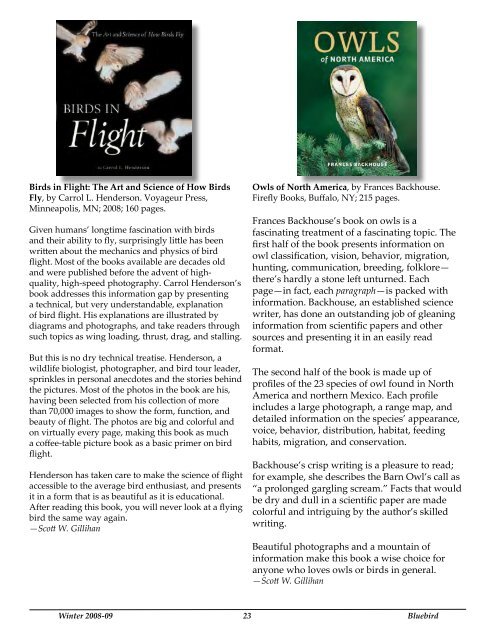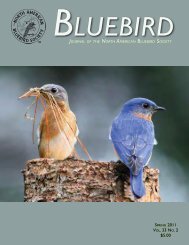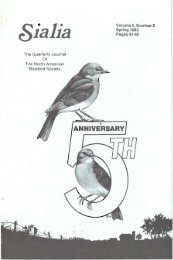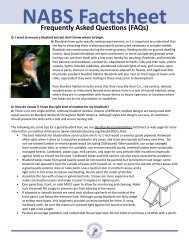Vol. 31, No. 1 - North American Bluebird Society
Vol. 31, No. 1 - North American Bluebird Society
Vol. 31, No. 1 - North American Bluebird Society
Create successful ePaper yourself
Turn your PDF publications into a flip-book with our unique Google optimized e-Paper software.
Birds in Flight: The Art and Science of How Birds<br />
Fly, by Carrol L. Henderson. Voyageur Press,<br />
Minneapolis, MN; 2008; 160 pages.<br />
Given humans’ longtime fascination with birds<br />
and their ability to fly, surprisingly little has been<br />
written about the mechanics and physics of bird<br />
flight. Most of the books available are decades old<br />
and were published before the advent of highquality,<br />
high-speed photography. Carrol Henderson’s<br />
book addresses this information gap by presenting<br />
a technical, but very understandable, explanation<br />
of bird flight. His explanations are illustrated by<br />
diagrams and photographs, and take readers through<br />
such topics as wing loading, thrust, drag, and stalling.<br />
But this is no dry technical treatise. Henderson, a<br />
wildlife biologist, photographer, and bird tour leader,<br />
sprinkles in personal anecdotes and the stories behind<br />
the pictures. Most of the photos in the book are his,<br />
having been selected from his collection of more<br />
than 70,000 images to show the form, function, and<br />
beauty of flight. The photos are big and colorful and<br />
on virtually every page, making this book as much<br />
a coffee-table picture book as a basic primer on bird<br />
flight.<br />
Henderson has taken care to make the science of flight<br />
accessible to the average bird enthusiast, and presents<br />
it in a form that is as beautiful as it is educational.<br />
After reading this book, you will never look at a flying<br />
bird the same way again.<br />
—Scott W. Gillihan<br />
Owls of <strong>No</strong>rth America, by Frances Backhouse.<br />
Firefly Books, Buffalo, NY; 215 pages.<br />
Frances Backhouse’s book on owls is a<br />
fascinating treatment of a fascinating topic. The<br />
first half of the book presents information on<br />
owl classification, vision, behavior, migration,<br />
hunting, communication, breeding, folklore—<br />
there’s hardly a stone left unturned. Each<br />
page—in fact, each paragraph—is packed with<br />
information. Backhouse, an established science<br />
writer, has done an outstanding job of gleaning<br />
information from scientific papers and other<br />
sources and presenting it in an easily read<br />
format.<br />
The second half of the book is made up of<br />
profiles of the 23 species of owl found in <strong>No</strong>rth<br />
America and northern Mexico. Each profile<br />
includes a large photograph, a range map, and<br />
detailed information on the species’ appearance,<br />
voice, behavior, distribution, habitat, feeding<br />
habits, migration, and conservation.<br />
Backhouse’s crisp writing is a pleasure to read;<br />
for example, she describes the Barn Owl’s call as<br />
“a prolonged gargling scream.” Facts that would<br />
be dry and dull in a scientific paper are made<br />
colorful and intriguing by the author’s skilled<br />
writing.<br />
Beautiful photographs and a mountain of<br />
information make this book a wise choice for<br />
anyone who loves owls or birds in general.<br />
—Scott W. Gillihan<br />
Winter 2008-09 23 <strong>Bluebird</strong>





